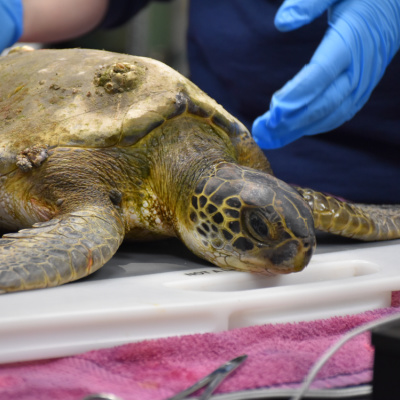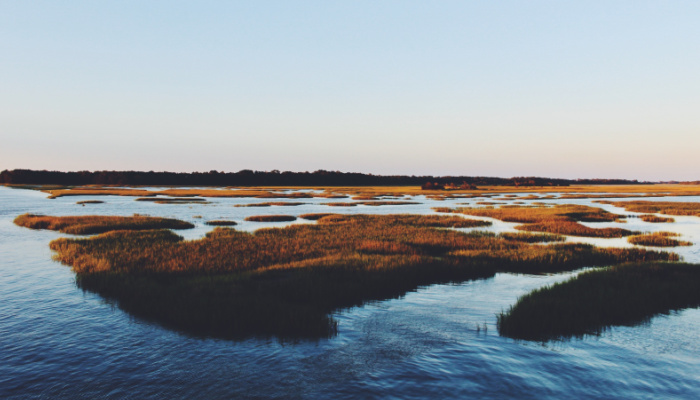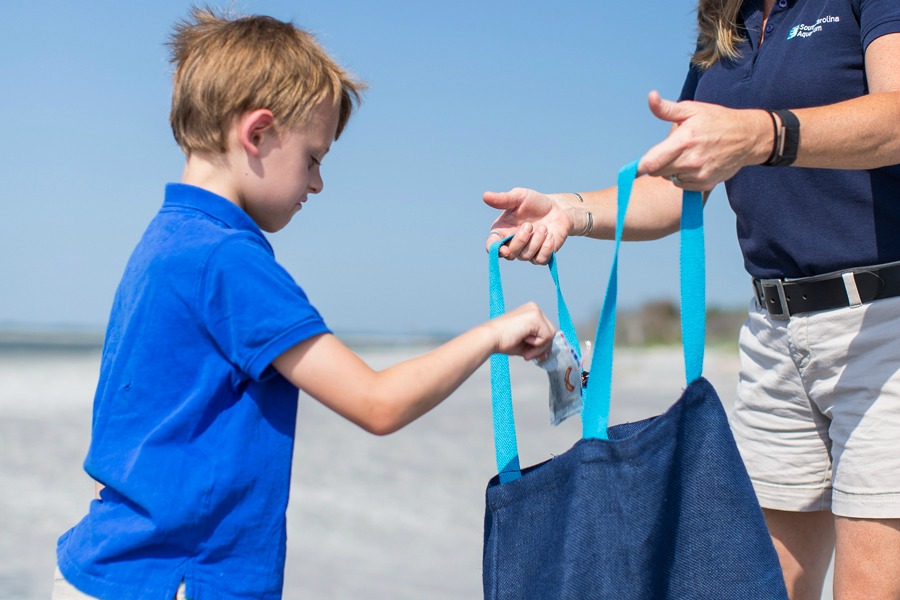Here at the Aquarium, we understand the intrinsic link between climate change and the charismatic animals we care for. Sea turtles are losing their nesting grounds as a result of rising seas and erosion. Some arrive at the Sea Turtle Care Center™ facing ailments like fibropapillomatosis, a disease that thrives in warming waters and causes debilitating tumors. Beyond our walls, research has shown that changing temperatures are forcing marine animals along our coastlines to shift their migratory patterns, upsetting a critical balance between species.
 Mercury, a recently admitted green sea turtle with FP tumors.
Mercury, a recently admitted green sea turtle with FP tumors.We see climate change impacts affecting us here on land, as well. We face regular road closures due to flooding, regardless if a storm has occurred recently or not. We await (and now expect) extreme weather conditions, like rain bombs and hurricanes, to hinder our routines in seasonal rotations.
While these challenges and the anticipation of them may seem like the new normal, the truth lies far beyond that. Together, with your help, we can commit to taking action against climate change.
Charleston’s Climate Action Plan
As part of their recently ratified Climate Action Plan, the City of Charleston has set out to reduce carbon emissions to 56% below 2018 levels by 2030 and net zero by 2050. The Plan is broken into 12 strategies comprising 51 individual, achievable action items to successfully hit these goals.

The Plan offers a multi-faceted approach to addressing climate change, with the following four pillars:
Buildings – improving infrastructure efficiency, reducing energy needs, incorporating renewable energy solutions, etc.
Transportation – increasing accessibility to electric charging stations, creating multi-modal transportation avenues, expanding options for alternative forms of transportation, etc.
Waste – creating pathways to recycling and composting, prioritizing alternatives to single-use plastic, minimizing organic materials in landfills, etc.
Carbon Sinks – planting trees on public and private property, protecting our preexisting carbon sinks (like the ocean, saltmarshes and wild oyster reefs), allocating new areas for natural, beneficial landscape, etc.
Central to the conceptualization of the Climate Action Plan was an emphasis on social equity throughout each of its focus areas. Research shows that vulnerable populations (including the elderly, chronically ill, lower-income, and BIPOC communities) are more susceptible to the impacts of climate change. These communities already experience institutional and systematic oppression that result in less access to resources, capital and services. That’s why each pillar, strategy and action item were vetted through this lens to ensure that all efforts would help, not hinder, those who face greater challenges due to inequity.
Taking climate action can lead to long-term cost savings, economic development and retention, better public health overall, habitat and wildlife protections, easier mobility, increased safety, beautification and preservation of our cultural heritage and so much more.
What can you do?
Each month, we’ll be delivering awareness and knowledge to your inboxes on a specific action you can adopt to alleviate climate change impacts in your own household, neighborhood and beyond. Don’t reside in Charleston? Don’t worry—these actions are applicable wherever you live. Who knows—they might inspire you to ask your own community to adopt a similar model!



